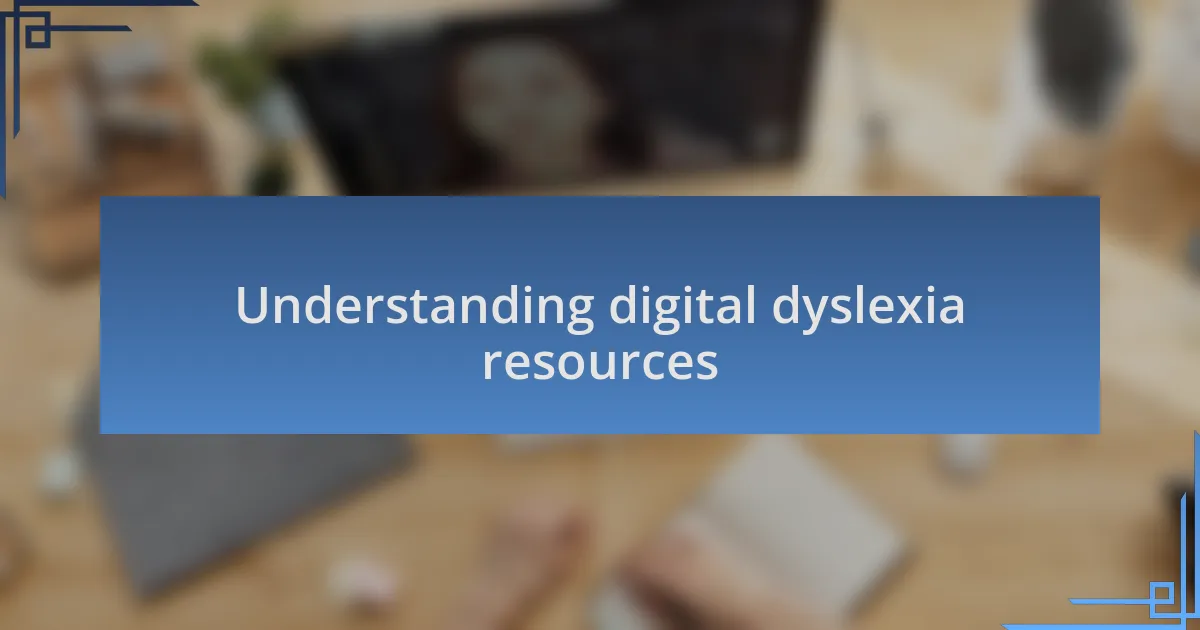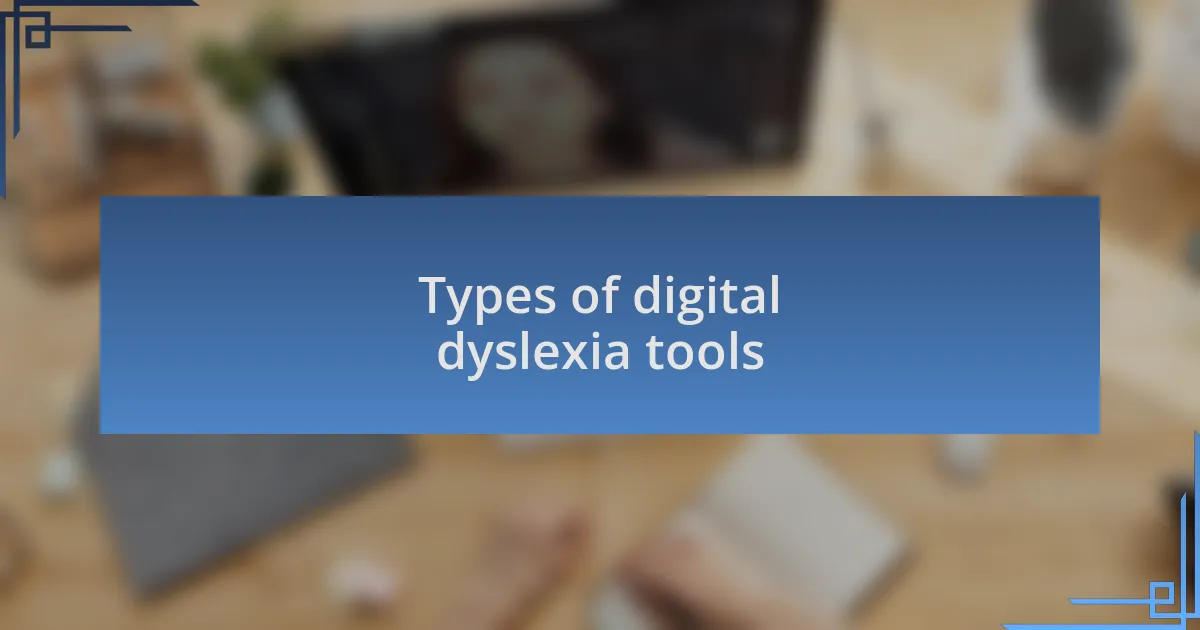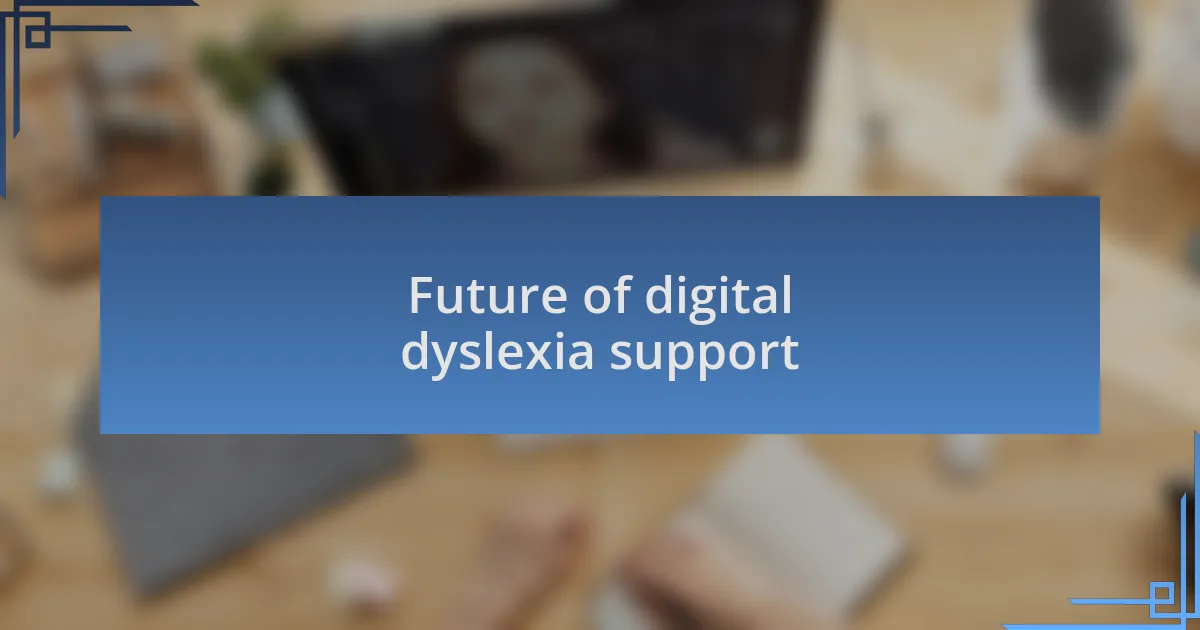Key takeaways:
- Digital dyslexia resources, including text-to-speech and word prediction software, significantly enhance reading and writing experiences for individuals with dyslexia.
- Effective dyslexia training for educators fosters empathy and equips them with strategies to create inclusive learning environments.
- Personalization of tools and ongoing community support greatly improves the effectiveness of dyslexia resources, leading to greater student engagement and confidence.
- The future of dyslexia support will likely focus on personalized learning experiences and immersive technologies, such as virtual reality, to better cater to individual needs.

Understanding digital dyslexia resources
Digital dyslexia resources encompass a variety of tools and strategies designed to aid individuals with dyslexia in navigating the complexities of reading and writing in today’s digital world. I remember the first time I discovered a text-to-speech app; it felt like a light bulb moment. How many young people might benefit from such tools but simply don’t know they exist?
One of the most encouraging aspects of these resources is their adaptability to individual learning styles. It’s fascinating to see how different platforms offer customized experiences—for instance, I always found that colored overlays helped reduce visual stress while reading on screens. Have you considered how these small adjustments could make a significant difference in someone’s learning journey?
Moreover, the sense of community surrounding digital dyslexia resources cannot be overlooked. Online forums and support groups create a safe space for sharing experiences and challenges, which can be incredibly validating. When I joined a group discussion about digital learning tools, it was comforting to hear others’ stories and realize I wasn’t alone in my struggle. Isn’t it powerful to connect with others who share similar experiences?

Importance of dyslexia training
Dyslexia training is crucial for building a solid foundation of understanding for educators and those who support individuals with dyslexia. I’ve seen firsthand how even a brief training session can dramatically shift a teacher’s approach to a struggling reader. Have you noticed how knowledge can empower others to make meaningful changes in their teaching methods?
Effective dyslexia training equips individuals with the tools and strategies needed to create inclusive learning environments. For example, after attending a workshop, I was inspired to incorporate multisensory techniques into my tutoring sessions. This change not only engaged my students more but also fostered a sense of confidence that I hadn’t seen before. Isn’t it amazing how targeted training can transform learning experiences?
Lastly, ongoing dyslexia training reinforces the importance of empathy and understanding in educational settings. I remember feeling overwhelmed as a student, and it’s heartening to see how educators equipped with the right training can better support those feelings. Training isn’t just about knowledge; it’s about cultivating compassion and a willingness to adapt, which ultimately benefits everyone involved.

Types of digital dyslexia tools
When it comes to digital dyslexia tools, there are several types that can significantly enhance a learner’s experience. For instance, text-to-speech software has been a game-changer in my tutoring sessions. I remember a student who struggled not just with reading, but also with self-doubt. By using a digital tool that read the text aloud, I saw a visible relief wash over her; suddenly, the content was accessible, and her confidence blossomed. Have you ever seen someone light up when they understand something for the first time?
Another essential type is digital notetaking tools, which allow for organizing thoughts without the pressure of traditional writing. These tools often include features like voice recording or graphic organizers, which I found beneficial when working with students who have difficulty expressing their ideas on paper. One particularly vivid memory is of a student who thrived when he could draw his thoughts instead of writing them down. The joy he felt in sharing his visual notes was palpable—doesn’t it show just how powerful these tools can be in unlocking potential?
Lastly, we’ve also seen the rise of word prediction software, which minimizes the strain of typing. I recall an instance when a student with significant writing challenges used such a tool to complete an assignment independently for the first time. His sheer joy at submitting work that he was proud of was unforgettable. Isn’t it incredible how technology can bridge gaps and create opportunities for success? These varied digital dyslexia tools are proving to be invaluable companions in the learning journey, each serving a specific need that transforms challenges into triumphs.

Evaluating effectiveness of resources
Evaluating the effectiveness of digital dyslexia resources can feel daunting, but it’s crucial to determine what truly works. In my experience, I often look for user feedback; the voices of learners can provide invaluable insights. For example, I remember a young student sharing how a particular reading app helped her break down complex texts. Her enthusiasm was contagious; it made me realize that the right tool can transform not just learning, but also a child’s relationship with reading.
Another important factor is adaptability. Resources should cater to individual needs and preferences. I once worked with a student who benefitted from voice recognition software, tailored to help him articulate his thoughts more freely. When he finally expressed how liberated he felt, it made me question: How often are we considering the personal journeys of these learners when assessing a tool’s effectiveness?
Lastly, I find it vital to reflect on retention and progress over time. While some resources may show quick improvements, I prefer to track long-term results. I recall a case where a student initially struggled to recall information, but with consistent use of a particular app, her retention skills significantly improved. Watching her confidence grow week by week reinforced my belief that true effectiveness lies in sustained engagement and development. Have you witnessed similar transformations?

My experiences with digital tools
My journey with digital tools has been quite enlightening. I distinctly remember trying out a mind-mapping app during a workshop. Initially, I found its colorful layout overwhelming, but as I began to use it, I discovered how it helped me visually connect ideas. Have you ever experienced that moment when a tool clicks perfectly for you? It was a revelation.
In a different scenario, I introduced a text-to-speech software to a group of students who often felt discouraged by reading. Watching their faces light up as the words transformed from daunting text to flowing speech was heartwarming. One student shared that it felt like she had a personal reading assistant. How powerful is it to unlock that feeling of support, especially when the journey can be filled with obstacles?
Moreover, I’ve observed that engagement levels tend to rise when using interactive tools. For instance, I often implemented gamified learning modules, which sparked a competitive spirit among my students. One day, a normally quiet student surprised me by leading his peers in a discussion about a game-based reading challenge. It made me wonder: could the right digital tools not only aid learning but also foster collaboration and community?

Tips for using dyslexia resources
When using dyslexia resources, it’s crucial to personalize your approach. I remember a time when I tailored a reading app’s settings to suit my needs, adjusting font size and background color. This minor tweak made a significant difference in my comfort level and reading speed. Have you considered how simple adjustments might enhance your experience with a specific resource?
Another tip is to familiarize yourself with the tools before fully integrating them into your routine. Once, I jumped right into a new software without exploring its features. It was frustrating, and I quickly realized I was missing out on so many helpful functions. Taking the time to explore can transform frustration into motivation, allowing you to leverage each resource’s full potential.
Finally, don’t hesitate to seek support from peers or online communities. During my early days using digital resources, I found a forum where users shared their own tips and tricks. It was a game-changer to engage with others who understood the struggle. Engaging with a community not only enhances your learning journey but also instills a sense of belonging. Have you connected with others on this path?

Future of digital dyslexia support
The future of digital dyslexia support is promising, especially with the rapid advancements in technology. I vividly remember the moment a new speech-to-text feature revolutionized my writing process. It opened doors that I once thought were closed, demonstrating how innovative tools can empower individuals to express themselves more freely. Could you imagine how such technology might evolve further to provide even greater assistance?
As we look ahead, personalized learning experiences are likely to take center stage in dyslexia resources. I’ve found that adapting content to my specific needs not only enhances my learning but also makes the experience feel far more engaging. What if we could have AI-driven programs that further tailor content based on our individual challenges and progress? Such tools could redefine what it means to receive support.
Moreover, the integration of immersive technologies, such as virtual reality (VR), is on the horizon. I often think back to how a simple interactive game helped me grasp reading concepts that traditional methods failed to convey. Imagine stepping into a virtual world designed specifically for dyslexic learners, where challenges are approached in a fun, hands-on way. Wouldn’t that change the game entirely for those who struggle with traditional learning environments?